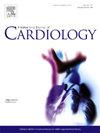The passability of delivery catheter system during self-expanding transcatheter aortic valve replacement: A CT-based prediction model
IF 3.2
2区 医学
Q2 CARDIAC & CARDIOVASCULAR SYSTEMS
引用次数: 0
Abstract
Objective
Aortic anatomy may pose challenges to the advancement of the delivery catheter system (DCS) and affect the outcome of self-expanding transcatheter aortic valve replacement (SE-TAVR). This study aimed to develop a preprocedural CT-based nomogram to predict the passability of DCS and clinical SE-TAVR outcomes.
Methods and results
Data of 348 patients who underwent transfemoral SE-TAVR were retrospectively collected from May 2018 to December 2023. A number of 118 patients received snare catheter, indicating poor DCS passaibility. All patients were randomized to development (n = 244) and validation (n = 104) sets. A predictive model was constructed by logistic regression and presented as a nomogram, which indicated that larger aortic angle, severe calcification, larger ascending aorta diameter, coronary ostial height of ≤10 mm, and bicuspid aortic valve were independent anatomical risk factors for poor DCS passability during SE-TAVR. Subsequently, the receiver operating characteristic (ROC) curve, calibration curve, and decision curve analysis (DCA) were depicted to assess the performance of the nomogram, revealing its good accuracy and concordance. This model also showed that patients with poor DCS passability were more likely to develop significant postprocedural paravalvular leak (PVL).
Conclusions
The model adequately predicts the DCS passability during SE-TAVR, which provides a comprehensive profile of risk factors for poor DCS passability and indicates coronary ostial height of ≤10 mm as a novel anatomical risk factor, in addition to the larger aortic angle, severe calcification, larger ascending aorta diameter, and bicuspid aortic valve. Patients with poor DCS passability are more likely to develop significant PVL.
自扩张经导管主动脉瓣置换术中输送导管系统的通过性:基于 CT 的预测模型
本文章由计算机程序翻译,如有差异,请以英文原文为准。
求助全文
约1分钟内获得全文
求助全文
来源期刊

International journal of cardiology
医学-心血管系统
CiteScore
6.80
自引率
5.70%
发文量
758
审稿时长
44 days
期刊介绍:
The International Journal of Cardiology is devoted to cardiology in the broadest sense. Both basic research and clinical papers can be submitted. The journal serves the interest of both practicing clinicians and researchers.
In addition to original papers, we are launching a range of new manuscript types, including Consensus and Position Papers, Systematic Reviews, Meta-analyses, and Short communications. Case reports are no longer acceptable. Controversial techniques, issues on health policy and social medicine are discussed and serve as useful tools for encouraging debate.
 求助内容:
求助内容: 应助结果提醒方式:
应助结果提醒方式:


